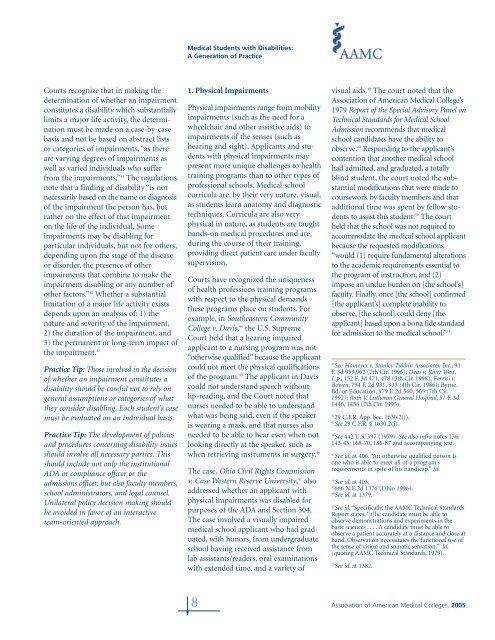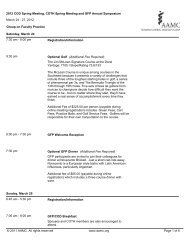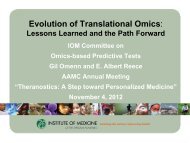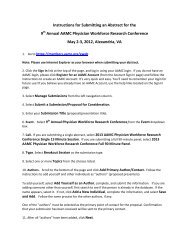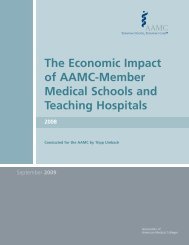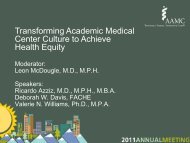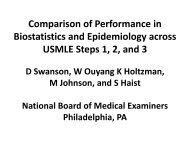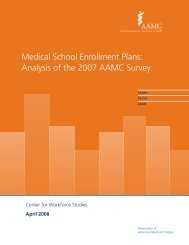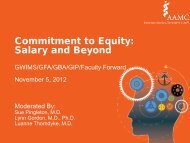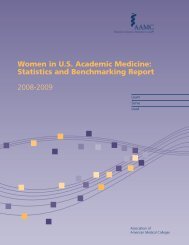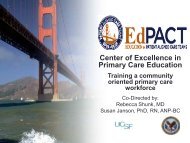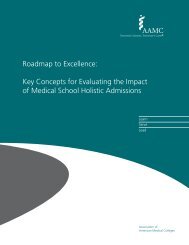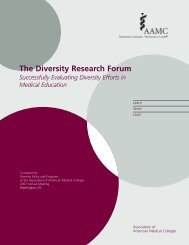Medical Students with Disabilities: A Generation of Practice
Medical Students with Disabilities: A Generation of Practice
Medical Students with Disabilities: A Generation of Practice
Create successful ePaper yourself
Turn your PDF publications into a flip-book with our unique Google optimized e-Paper software.
<strong>Medical</strong> <strong>Students</strong> <strong>with</strong> <strong>Disabilities</strong>:<br />
A <strong>Generation</strong> <strong>of</strong> <strong>Practice</strong><br />
Courts recognize that in making the<br />
determination <strong>of</strong> whether an impairment<br />
constitutes a disability which substantially<br />
limits a major life activity, the determination<br />
must be made on a case-by-case<br />
basis and not be based on abstract lists<br />
or categories <strong>of</strong> impairments, “as there<br />
are varying degrees <strong>of</strong> impairments as<br />
well as varied individuals who suffer<br />
from the impairments.” 41 The regulations<br />
note that a finding <strong>of</strong> disability “is not<br />
necessarily based on the name or diagnosis<br />
<strong>of</strong> the impairment the person has, but<br />
rather on the effect <strong>of</strong> that impairment<br />
on the life <strong>of</strong> the individual. Some<br />
impairments may be disabling for<br />
particular individuals, but not for others,<br />
depending upon the stage <strong>of</strong> the disease<br />
or disorder, the presence <strong>of</strong> other<br />
impairments that combine to make the<br />
impairment disabling or any number <strong>of</strong><br />
other factors.” 42 Whether a substantial<br />
limitation <strong>of</strong> a major life activity exists<br />
depends upon an analysis <strong>of</strong>: 1) the<br />
nature and severity <strong>of</strong> the impairment,<br />
2) the duration <strong>of</strong> the impairment, and<br />
3) the permanent or long-term impact <strong>of</strong><br />
the impairment. 43<br />
<strong>Practice</strong> Tip: Those involved in the decision<br />
<strong>of</strong> whether an impairment constitutes a<br />
disability should be careful not to rely on<br />
general assumptions or categories <strong>of</strong> what<br />
they consider disabling. Each student’s case<br />
must be evaluated on an individual basis.<br />
<strong>Practice</strong> Tip: The development <strong>of</strong> policies<br />
and procedures concerning disability issues<br />
should involve all necessary parties. This<br />
should include not only the institutional<br />
ADA or compliance <strong>of</strong>ficer or the<br />
admissions <strong>of</strong>ficer, but also faculty members,<br />
school administrators, and legal counsel.<br />
Unilateral policy decision making should<br />
be avoided in favor <strong>of</strong> an interactive<br />
team-oriented approach.<br />
1. Physical Impairments<br />
Physical impairments range from mobility<br />
impairments (such as the need for a<br />
wheelchair and other assistive aids) to<br />
impairments <strong>of</strong> the senses (such as<br />
hearing and sight). Applicants and students<br />
<strong>with</strong> physical impairments may<br />
present more unique challenges to health<br />
training programs than to other types <strong>of</strong><br />
pr<strong>of</strong>essional schools. <strong>Medical</strong> school<br />
curricula are, by their very nature, visual,<br />
as students learn anatomy and diagnostic<br />
techniques. Curricula are also very<br />
physical in nature, as students are taught<br />
hands-on medical procedures and are,<br />
during the course <strong>of</strong> their training,<br />
providing direct patient care under faculty<br />
supervision.<br />
Courts have recognized the uniqueness<br />
<strong>of</strong> health pr<strong>of</strong>essions training programs<br />
<strong>with</strong> respect to the physical demands<br />
these programs place on students. For<br />
example, in Southeastern Community<br />
College v. Davis, 44 the U.S. Supreme<br />
Court held that a hearing impaired<br />
applicant to a nursing program was not<br />
“otherwise qualified” because the applicant<br />
could not meet the physical qualifications<br />
<strong>of</strong> the program. 45 The applicant in Davis<br />
could not understand speech <strong>with</strong>out<br />
lip-reading, and the Court noted that<br />
nurses needed to be able to understand<br />
what was being said, even if the speaker<br />
is wearing a mask, and that nurses also<br />
needed to be able to hear even when not<br />
looking directly at the speaker, such as<br />
when retrieving instruments in surgery. 46<br />
The case, Ohio Civil Rights Commission<br />
v. Case Western Reserve University, 47 also<br />
addressed whether an applicant <strong>with</strong><br />
physical impairments was disabled for<br />
purposes <strong>of</strong> the ADA and Section 504.<br />
The case involved a visually impaired<br />
medical school applicant who had graduated,<br />
<strong>with</strong> honors, from undergraduate<br />
school having received assistance from<br />
lab assistants/readers, oral examinations<br />
<strong>with</strong> extended time, and a variety <strong>of</strong><br />
visual aids. 48 The court noted that the<br />
Association <strong>of</strong> American <strong>Medical</strong> College’s<br />
1979 Report <strong>of</strong> the Special Advisory Panel on<br />
Technical Standards for <strong>Medical</strong> School<br />
Admission recommends that medical<br />
school candidates have the ability to<br />
observe. 49 Responding to the applicant’s<br />
contention that another medical school<br />
had admitted, and graduated, a totally<br />
blind student, the court noted the substantial<br />
modifications that were made to<br />
coursework by faculty members and that<br />
additional time was spent by fellow students<br />
to assist this student. 50 The court<br />
held that the school was not required to<br />
accommodate the medical school applicant<br />
because the requested modifications<br />
“would (1) require fundamental alterations<br />
to the academic requirements essential to<br />
the program <strong>of</strong> instruction, and (2)<br />
impose an undue burden on [the school’s]<br />
faculty. Finally, once [the school] confirmed<br />
[the applicant’s] complete inability to<br />
observe, [the school] could deny [the<br />
applicant] based upon a bona fide standard<br />
for admission to the medical school.” 51<br />
41<br />
See Homeyer v. Stanley Tukhin Associates, Inc.,91<br />
F. 3d 959,962 (7th Cir. 1996); Deas v. River West,<br />
L.p., 152 F. 3d 471, 478 (5th Cir. 1998); Forrisi v.<br />
Bowen, 794 F. 2d 931, 933 (4th Cir. 1986); Byrne.<br />
Bd. or Education, 979 F. 2d 560, 565 (7th Cir.<br />
1992); Roth V. Lutheran General Hospital, 57 F. 3d<br />
1446, 1454 (7th Cir. 1995).<br />
42<br />
29 C.F.R. App. Sec. 1630.2(j).<br />
43<br />
See 29 C.F.R. § 1630.2(j).<br />
44<br />
See 442 U.S. 397 (1979). See also infra notes 136,<br />
143-45, 168-70, 186-87 and accompanying text.<br />
45<br />
See id. at 406. “An otherwise qualified person is<br />
one who is able to meet all <strong>of</strong> a program’s<br />
requirements in spite <strong>of</strong> his handicap.” Id.<br />
46<br />
See id. at 403.<br />
47<br />
666 N.E.2d 1376 (Ohio 1996).<br />
48<br />
See id. at 1379.<br />
49<br />
See id. “Specifically, the AAMC Technical Standards<br />
Report states, ‘[t]he candidate must be able to<br />
observe demonstrations and experiments in the<br />
basic sciences . . . . A candidate must be able to<br />
observe a patient accurately at a distance and close at<br />
hand. Observation necessitates the functional use <strong>of</strong><br />
the sense <strong>of</strong> vision and somatic sensation.’” Id.<br />
(quoting AAMC Technical Standards, 1979).<br />
50<br />
See id. at 1382.<br />
8 Association <strong>of</strong> American <strong>Medical</strong> Colleges, 2005


